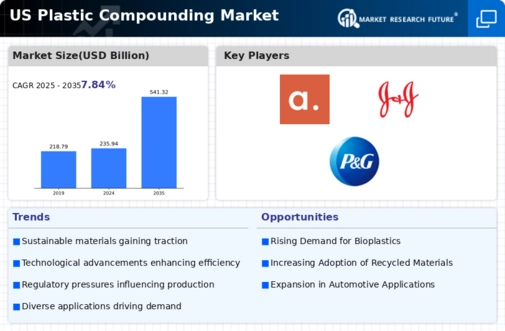The plastic compounding market in the US is characterized by a dynamic competitive landscape, driven by innovation, sustainability, and strategic partnerships. Key players such as BASF (DE), LyondellBasell (US), and DuPont (US) are actively shaping the market through their operational focuses. BASF (DE) emphasizes innovation in sustainable materials, while LyondellBasell (US) is enhancing its production capabilities to meet rising demand. DuPont (US) is leveraging its expertise in advanced materials to cater to diverse applications, collectively influencing the competitive environment by fostering a culture of continuous improvement and adaptation.
Business tactics within the plastic compounding market include localizing manufacturing and optimizing supply chains to enhance efficiency and responsiveness. The market structure appears moderately fragmented, with several key players exerting considerable influence. This fragmentation allows for niche players to thrive, while larger companies leverage their scale to optimize operations and expand their market share.
In October 2025, BASF (DE) announced a partnership with a leading automotive manufacturer to develop bio-based compounds aimed at reducing carbon footprints. This strategic move underscores BASF's commitment to sustainability and positions it favorably within the growing eco-conscious consumer segment. The collaboration is expected to enhance BASF's product offerings and strengthen its market position in the automotive sector.
In September 2025, LyondellBasell (US) unveiled a new production facility in Texas, aimed at increasing its capacity for high-performance compounds. This expansion is significant as it not only addresses the rising demand for advanced materials but also reinforces LyondellBasell's commitment to regional manufacturing. The facility is anticipated to create numerous jobs and contribute to local economic growth, while also enhancing the company's supply chain resilience.
In August 2025, DuPont (US) launched a new line of engineering thermoplastics designed for the electronics industry. This introduction reflects DuPont's strategic focus on innovation and its ability to respond to evolving market needs. By diversifying its product portfolio, DuPont aims to capture a larger share of the electronics market, which is increasingly demanding high-performance materials.
As of November 2025, current competitive trends in the plastic compounding market are heavily influenced by digitalization, sustainability initiatives, and the integration of AI technologies. Strategic alliances are becoming increasingly vital, as companies seek to enhance their capabilities and market reach. The competitive differentiation is likely to evolve from traditional price-based competition towards a focus on innovation, technological advancements, and supply chain reliability, indicating a shift in how companies position themselves in the market.














Leave a Comment